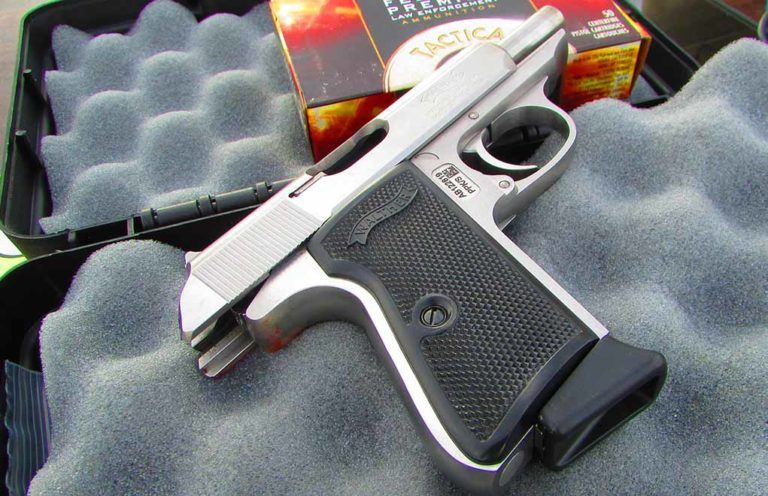
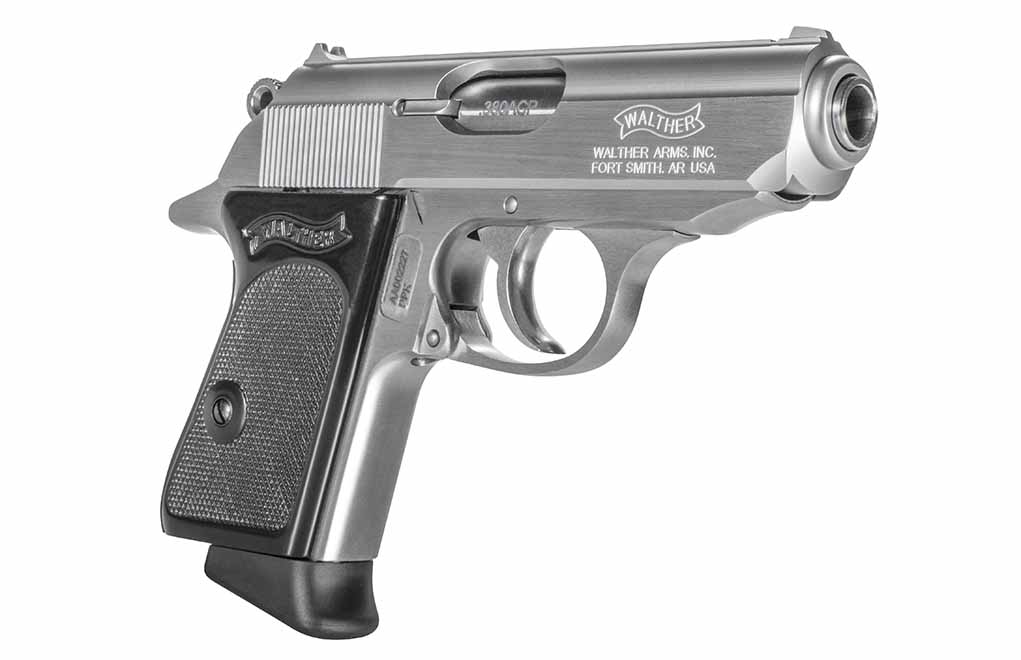
Re-released purely under the Walther banner, the historic PPK and PPK/S are back.
How The Walther PPK/S Is Better Than Ever:
- Slide manufactured in Germany, while the rest of the pistol is made in Walther's Ft. Smith factory.
- More machined parts ensure the pistol has an overall tighter fit.
- Beavertail, added when Smith & Wesson was the licensed manufacturer, remains for a more intuitive grip.
- Excellent double-action and single-action trigger, with minute 1/8-inch reset.
- Fixed-barrel design remains as accurate as ever.
Like most Americans, my infatuation with the Walther PPK stemmed from a fictitious British spy. “James Bond” probably did more to drive the interest in the minute German gem than Clint Eastwood’s “Dirty Harry” did for the Smith & Wesson Model 29. The deadly, blued masterpiece was as tantalizing as a freshly pressed tuxedo and as mysterious as a plot to rule the world. And from the beginning, I was hooked.
Of course, coming of age at the turn of the last century, the PPK wasn’t as prevalent. Instead, the PPK/S was all the rage. While it might not have been a faithful facsimile of the pistol that defeated “The Man With the Golden Gun” or sent “Goldfinger” off to play his golden harp, it was close enough for me. Maybe even better.
The PPK is unarguably the more historic of the well-known Walther line, but the PPK/S is perhaps the more practical. Slightly larger to meet U.S. import standards, it’s always felt better in my hand; and, in general, I’ve found it more pleasurable to shoot. Demure as it might be, the .380 ACP has the stuff to make a pistol jump, so anything that negates that is welcome.
From my perspective, the PPK/S had, and still has, all the makings of the finest .380 ACP to come down the line. And, with it and the PPK hitting the market again (purely under the Walther banner), the long-on-class-and-performance pistol is proving better than ever.
The Comeback
The PPK and PPK/S are popular—so popular, in fact, that rarely a day has gone by for the past six years that the suits at Walther haven’t heard from some forlorn shooter about their absence.
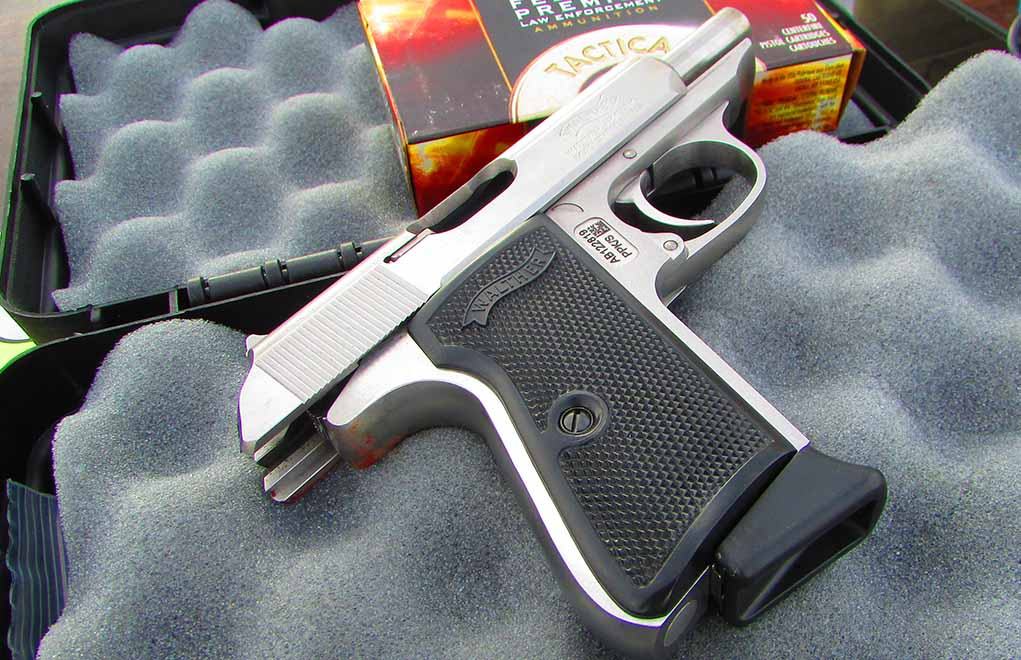
If it hadn’t hit your radar, when Smith & Wesson’s licensing agreement ran out with Walther in 2012, so did the supply of new PPK and PPK/S pistols. But with roots established in Fort Smith, Arkansas, Walther found no better time than now to start cranking out the miniature masterpieces. And, the company has repledged itself to the design, ensuring the pistols live up to their impeccable reputations.
Where this is most noticeable is in the way these pistols are now manufactured. Walther Marketing Manager Cody Osborn explained that the company put a lot of thought into exactly what should go into the PPK and PPK/S and what would make them tick like finely tuned Teutonic timepieces.
This added up to more machined parts—not that there’s anything wrong with cast firearms parts, particularly in the modern process. Nevertheless, machining generally still means tighter tolerances and, in turn, a more sharply fitted firearm. It’s a process that should prove out with exceptional performance and accuracy every time the trigger is pulled.
Get More Self-Defense Information:
- Concealed Carry Sights: Which Are Best For Your Gun?
- XS Sights: The F8 Definitely A Sight To See
- Concealed Carry: Concealing A Single-Action Revolver
- 3 Simple Rules For Choosing A Defensive Handgun And Ammo
A majority of this is accomplished at the company’s high-tech facility in Fort Smith, which is in the heart of custom gun country. But it was heartening to learn that the PPK and PPK/S aren’t completely American made. This is not a dig against American craftmanship, but a German classic should have German-made parts … at least some. Given the legacy of the pistols, a bit of me yearns for a 100 percent German heater, but Walther has done the next best thing: The slides are milled at the company’s main factory in Ulm, Germany, and are then mated with the Arkansas end of things.
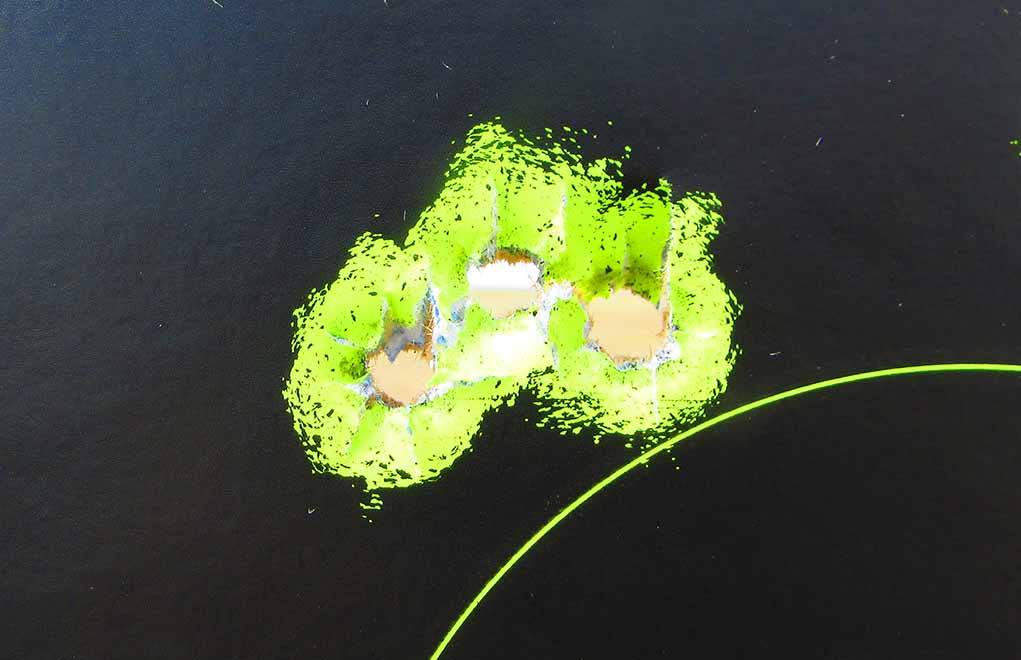
One might consider it the best of both worlds, although it’s no easy task. Given that operations are an ocean away, there’s plenty that could go wrong. A micrometer here or there, and the pistols could rattle around like kerosene-fueled Eastern bloc ramblers. But this was an unfounded concern, as I discovered when I cracked open the hard case of the PPK/S Walther sent me.
Diamonds Are Forever
All guns are meant to be shot. Only a few are worth admiring. And I did my share of the latter when I first laid hands on Walther’s dapper .380 Auto. It features a pure stainless steel slide and frame—only interrupted by jet-black grips. The PPK/S couldn’t have shone brighter if it had been made of diamonds. And it remains familiar, too.
Not getting carried away and trying to reinvent the wheel, Walther kept the design of the PPK/S nearly identical to what was last produced. One aspect to heave a big sigh of relief about is the retention of the extended beavertail, which came about under Smith & Wesson’s watch.
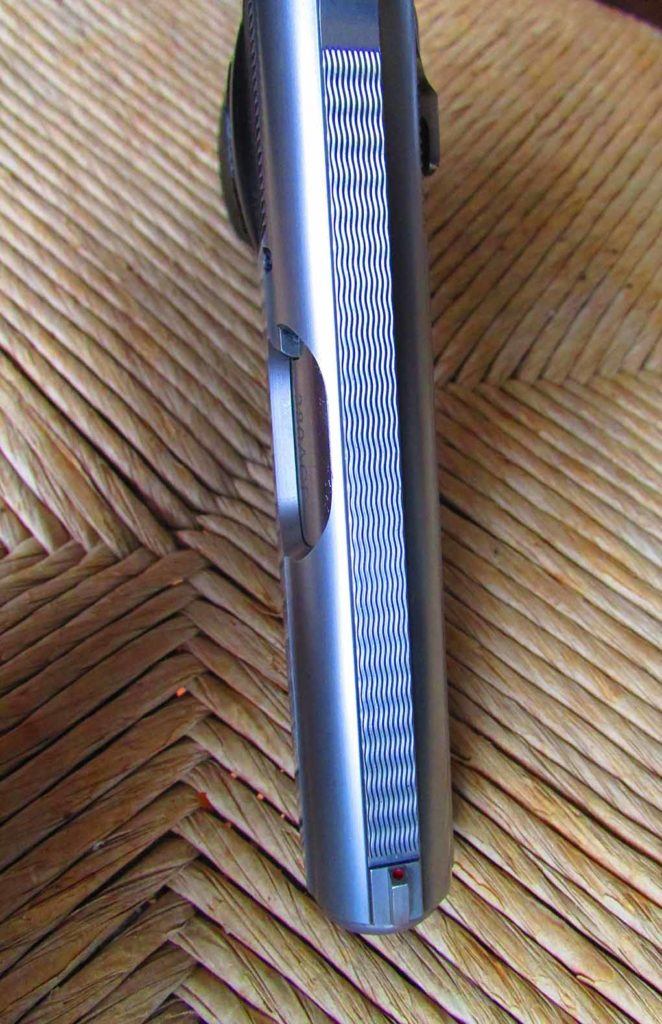
Given the economy of design, the PPK/S doesn’t have a ton of real estate to get its job done. In turn, before this addition, the pistol was known to have a nasty bite if you didn’t pay attention to your hand placement. Besides, a beavertail makes a pistol quicker-handling (in my opinion), giving you solid geography to get a good grip on it the minute you draw—no second thoughts.
Nevertheless, there are some things that aren't the same as the last iteration of the PPK/S. Gone are the rear dovetail sights. This left me a bit disappointed. I’m a nut for tradition; in most cases, I like to see a timeless design executed as closely as possible to the original. An integral rear sight certainly fits this bill for the PPK/S.
However, if someone in the Ulm factory didn’t have his CNC machine dialed in the day he made mine, well, there’s a lot more that goes into getting the pistol to hit at point of aim—at the very least, a trip to the gunsmith. Thankfully, this was not an issue with the one I had in my possession (more on that later).
For those who’ve never handled a PPK/S, it’s akin to taking a grip on an oxymoron: a “regular jumbo shrimp.” On the “shrimp” side, the pistol is small; it’s 1 inch wide, about 4 inches high and a whisker more than 6 inches in overall length. As for the “jumbo” side: If this German-American heater weren’t so heavy, it would be bordering on pocket pistol territory. The gun’s heft is akin to a Glock 17—a pistol that’s magnitudes larger—without its magazine.

If it were escorting me out of the house, I’d want it on my hip; but truthfully, it’s still viable for pocket carry. I experimented with this a bit, toting it in an Allen No-Sho pocket holster. Yup, heavy. Even so, as long as you have a pair of britches that won’t ankle on you with weight, it’s comfortable.
Either way, hip or hip pocket, the pistol is more than viable for defensive duty, as my trip to the range more than confirmed.
Among The Greats
For those who are unfamiliar with the PPK/S, its pedigree is unimpeachable. Starting with the PP in 1929, Carl Walther cooked up arguably the greatest line of simple blowback centerfire pistols ever to pitch jacketed lead. What makes the system so special is its fixed barrel, which creates a natural pointer … a deadly accurate one at that—a fact more than confirmed when I started to pull the trigger.
I’m not an off-the-carts marksman by any stretch of the imagination, but the pistol inflated my ego when my first three shots chipped away a nearly perfect cloverleaf at 15 yards. From there, it was off to the races.
Everything I ran through this slight pistol went where I wanted it to, but it seemed particularly fond of the 99-grain Federal Premium HST. The jacketed, hollow-point, defensive ammo produced the best group of the day—1.5 inches on five shots from single-action and off a rest at 15 yards. Impressive, given the pistol’s terse, 3.3-inch barrel and abbreviated grip.
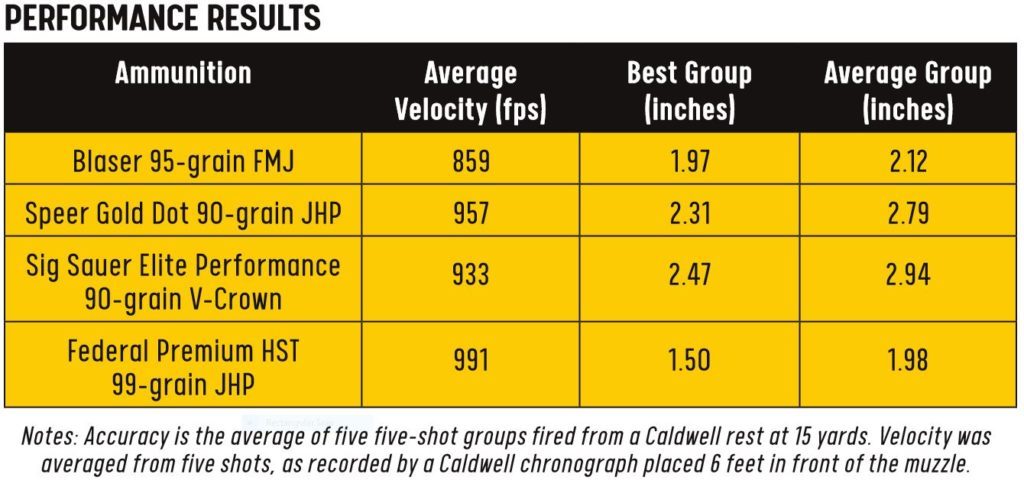
The Walther gave my medium-sized hands just enough room to work, especially with the grip extender magazine. Its flush-fit magazine, as expected, let my pinky fall off the end. Despite this and the lack of any checkering on the front strap or mainspring housing, the PPK/S was still controllable. The grip circumference was on the money for me, so the black plastic panels were more than enough to keep the gun reined in and in place. However, I could see larger-mitted shooters having to struggle to find the right purchase.
I’m familiar with the DA/SA trigger on the PPK/S. As a result, I knew that historically, its double-action measured in on the heavy side. So it was with the reboot pistol. I could feel every ounce of the 13-pound pull weight. Yet, I can’t complain, given that the DA stage is superb, never stacking and extremely smooth—even stageable. Plus, the trigger is wide, giving my finger plenty of play in finding a comfortable and efficient placement a hair past its pad.
From there, I could crack a well-aimed shot from double-action but still be in position to take full advantage of the single-action stage that, in a word, is phenomenal. It breaks at about 6 pounds, so accuracy is second nature on the PPK/S when its hammer is back.
But the reset is where the pistol really shone for me—a mere 1/8 inch; and when I used it to its full potential, the two seven-round magazines that come with the PPK/S disappeared in a wink.
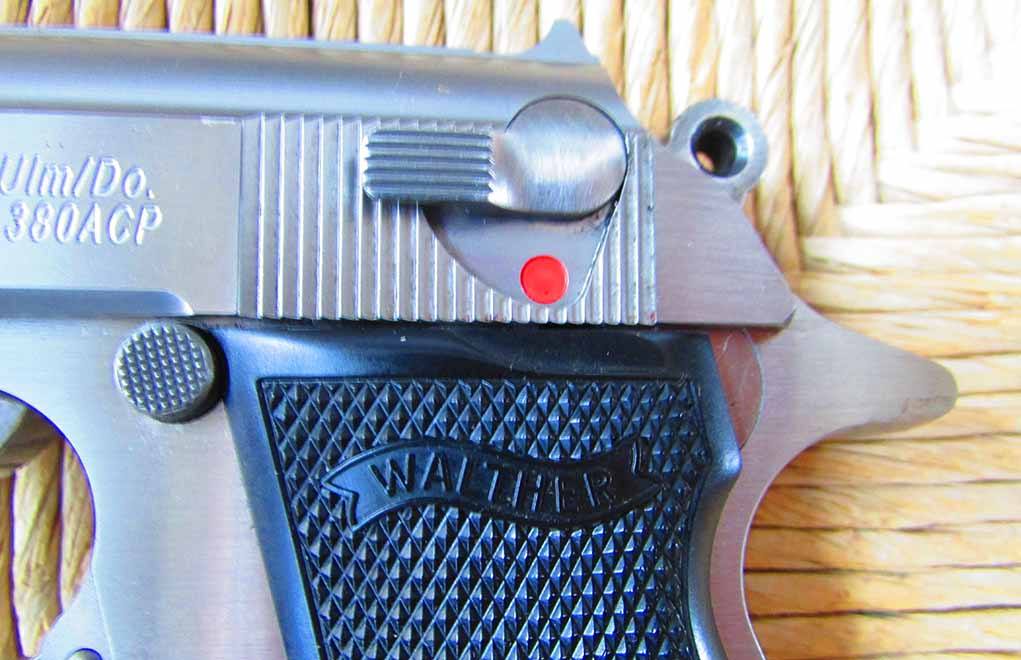
The PPK/S certainly has the chops for range candy, but it’s more than viable as a defensive gun. Its weight soaked up the recoil, even on the hottest loads. The magazines dropped on reloads as if they were greased. And even the safety/de-cocker, despite being close to flush with the cocking serrations, obeyed the flick of my thumb.
Furthermore, it chewed through everything I fed it. This is historically not the case with the PPK/S, which has been known to be temperamental when it comes to ammo. I had one stoppage, but I’ll chalk that up to poor discipline on my part: gripping the pistol too high and impeding the slide. I learned my lesson (and I have the slide-bite to prove it).
Magazine-Ammo Compatibility
Nice as the pistol was, I encountered one issue: its magazines’ compatibility with Sig Sauer Elite Performance 90-grain JHP ammo. It seemed that if the bullet was seated high, it wouldn’t load into the magazine. I confirmed this at home, measuring my remaining Sig ammo. I discovered that those at or above .957 inch (well within the .984 inch SAAMI standards for the cartridge) didn’t play nice with the magazines. Below that, they did.
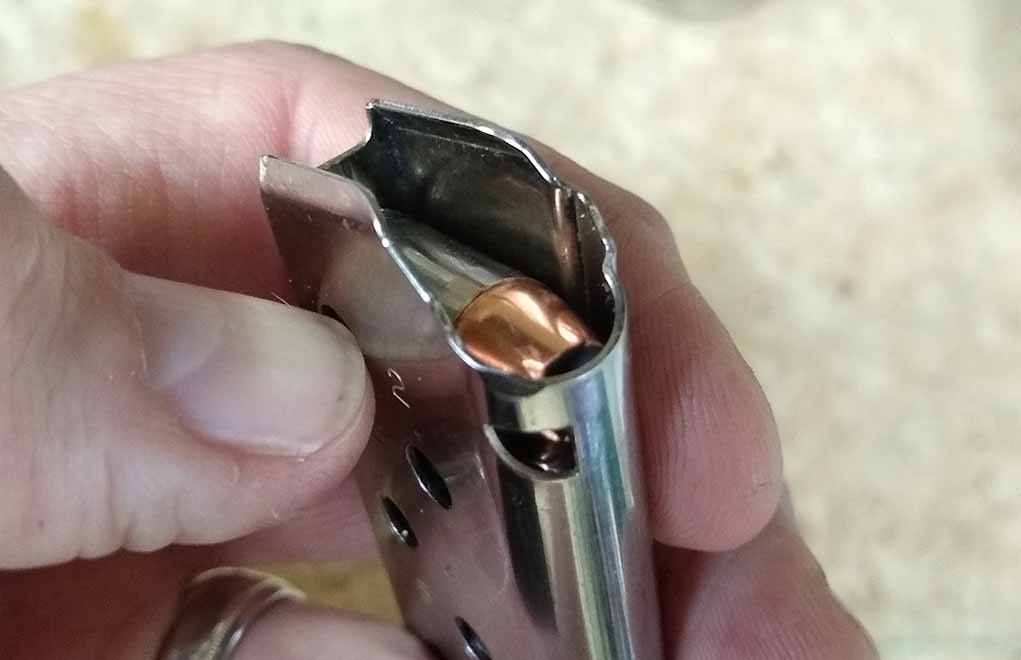
When I pointed this out to Cody Osborn at Walther, he said the pistol’s magazine was developed before this particular ammunition was in existence, adding that the company is now cognizant of it and is presently finding out if anything can be done to address the issue.
From my experience, given all the other good qualities of the PPK/S, this wasn’t a deal-breaker. Shooters will know if a certain round is incompatible the moment they try to load the magazine.
Parting Shot
Over the decades, Walther has fully lived up to the reputation of fine German engineering. The reintroduction of the PPK/S is a tribute to this. With Walther keeping in-house tabs on how it (and the PPK) rolls off its assembly line, the pistol is as fine as ever. And versatile.
Whether as an addition to a collection, a .380 plinker for range relaxation or a deadly serious concealed-carry pistol, the PPK/S is more than ready to fill these roles.
The only remaining question is whether you have the formal wear to go with the pistol.
Editor's Note: This article originally appeared in the 2019 Shooter's Guide issue of Gun Digest the Magazine.

Next Step: Get your FREE Printable Target Pack
Enhance your shooting precision with our 62 MOA Targets, perfect for rifles and handguns. Crafted in collaboration with Storm Tactical for accuracy and versatility.
Subscribe to the Gun Digest email newsletter and get your downloadable target pack sent straight to your inbox. Stay updated with the latest firearms info in the industry.

![Best Concealed Carry Guns In 2025 [Field Tested] Wilson Combat EDC X9S 1](https://gundigest.com/wp-content/uploads/Wilson-Combat-EDC-X9S-1-324x160.jpg)


![Best 9mm Carbine: Affordable PCCs [Tested] Ruger Carbine Shooting](https://gundigest.com/wp-content/uploads/Ruger-Carbine-Shooting-100x70.jpg)
![Best AR-15: Top Options Available Today [Field Tested] Harrington and Richardson PSA XM177E2 feature](https://gundigest.com/wp-content/uploads/Harrington-and-Richardson-PSA-XM177E2-feature-100x70.jpg)
